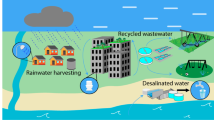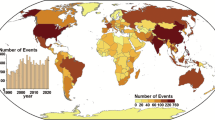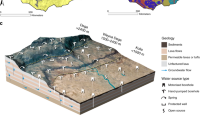Abstract
The interest in quick technologic fixes to complex water problems increases during extreme hydroclimatic events. However, past evidence shows that such fixes might be associated with unintended consequences. We revisit the idea of using shade balls in the Los Angeles reservoir to reduce evaporation during the recent drought in California, and question its sustainability by revealing the water footprint of this technologic water conservation solution.
This is a preview of subscription content, access via your institution
Access options
Access Nature and 54 other Nature Portfolio journals
Get Nature+, our best-value online-access subscription
$29.99 / 30 days
cancel any time
Subscribe to this journal
Receive 12 digital issues and online access to articles
$119.00 per year
only $9.92 per issue
Buy this article
- Purchase on Springer Link
- Instant access to full article PDF
Prices may be subject to local taxes which are calculated during checkout

Similar content being viewed by others
References
Dai, A. Nat. Clim. Change 3, 52–58 (2013).
Hogeboom, R. J., Knook, L. & Hoekstra, A. Y. Adv. Water Resour. 113, 285–294 (2018).
Craig, I. P. Loss of Water Storage Due to Evaporation—A Literature Review (NCEA, Univ. Southern Queensland, Toowoomba, 2005).
Assouline, S., Narkis, K. & Or, D. Water Resour. Res. 47, W07506 (2011).
Aminzadeh, M., Lehmann, P. & Or, D. Hydrol. Earth Syst. Sci. Discuss. https://doi.org/10.5194/hess-2017-415 (2017).
De Graaf, M. How the 100 million ‘shade balls’ brought in to protect LA’s reservoir from evaporating are in fact a ‘bacterial nightmare’. Daily Mail (20 August 2015).
Hoekstra, A. Y., Chapagain, A. K., Aldaya, M. M. & Mekonnen, M. M. The Water Footprint Assessment Manual: Setting the Global Standard (Earthscan, London, 2011).
Boustead, I. Eco-Profiles of the European Plastics Industry: High Density Polyethylene (HDPE) (Plastics Europe, 2005).
Feraldi, R. et al. Cradle-to-Gate Life Cycle Inventory of Nine Plastic Resins and Four Polyurethane Precursors (Franklin Associates, Eastern Research Group, 2011).
Mekonnen, M. M., Gerbens-Leenes, P. W. & Hoekstra, A. Y. Environ. Sci. Water Res. Technol. 1, 285–297 (2015).
Madani, K. & Khatami, S. Curr. Sustain. Energy Rep. 2, 10–16 (2015).
Holland, R. A. et al. Proc. Natl Acad. Sci. USA 112, E6707–E6716 (2015).
Hellweg, S. & Milà i Canals, L. Science 344, 1109–1113 (2014).
Gohari, A. et al. J. Hydrol. 491, 23–39 (2013).
Mirchi, A., Watkins, D. & Madani, K. in Watersheds: Management, Restoration and Environmental Impact (ed. Vaughn, J. C.) 221–244 (Nova Science, New York, 2010).
Mady, B., Lehmann, P. & Or, D. Geophys. Res. Abstr. EGU Gen. Assem. 20, 11778 (2018).
Jaeger, H. M. & Nagel, S. R. Science 255, 1523–1531 (1992).
Acknowledgements
E.H. acknowledges funding from the Swiss National Science Foundation (grant number P2EZP2-165244).
Author information
Authors and Affiliations
Contributions
E.H. and K.M. conceived and designed the study. All authors performed the research, analysed the data and wrote the paper.
Corresponding author
Ethics declarations
Competing interests
The authors declare no competing interests.
Additional information
Publisher’s note: Springer Nature remains neutral with regard to jurisdictional claims in published maps and institutional affiliations.
Rights and permissions
About this article
Cite this article
Haghighi, E., Madani, K. & Hoekstra, A.Y. The water footprint of water conservation using shade balls in California. Nat Sustain 1, 358–360 (2018). https://doi.org/10.1038/s41893-018-0092-2
Received:
Accepted:
Published:
Issue Date:
DOI: https://doi.org/10.1038/s41893-018-0092-2
This article is cited by
-
Environmental footprints of soybean production in China
Environment, Development and Sustainability (2023)
-
Drivers and impacts of Eastern African rainfall variability
Nature Reviews Earth & Environment (2023)
-
Evaporation Mitigation Assessment by Self-assembled Nano-thickness Films in Shallow Fresh Water Lake Using Fixed and Semi-Floating Pans
Environmental Processes (2022)
-
Introducing affordable and accessible physical covers to reduce evaporation from agricultural water reservoirs and pools (field study, statistics, and intelligent methods)
Arabian Journal of Geosciences (2021)



